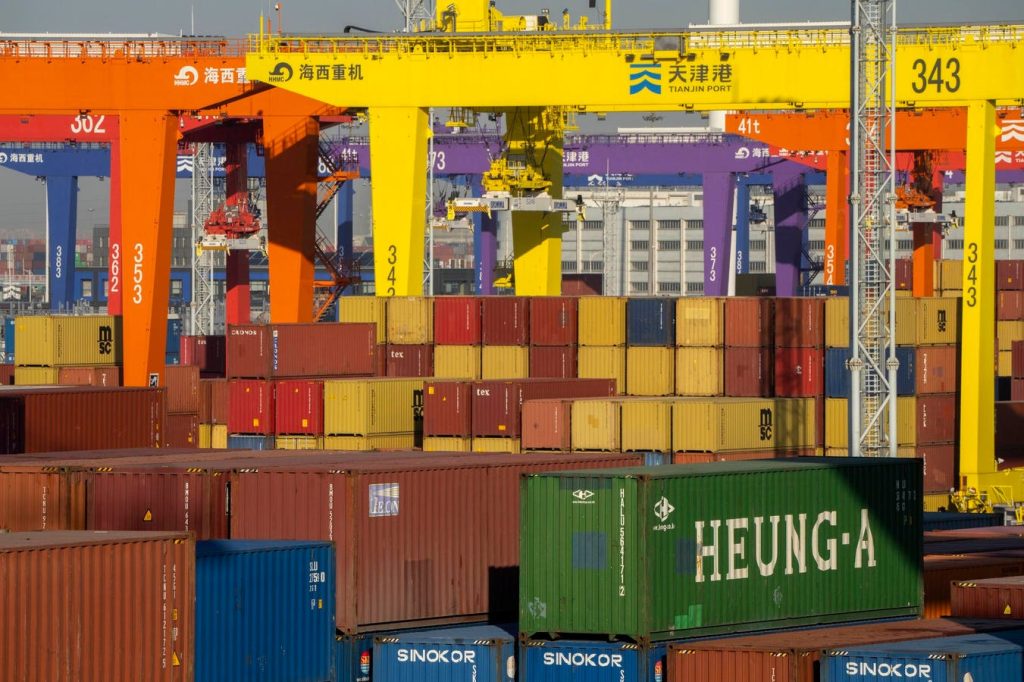FILE – Shipping containers are stacked at a port in Tianjin, China, Monday, Jan. 16, 2023. (AP … [+]
There is nothing wrong with reconsidering how the U.S. pays for government. There is nothing wrong with criticizing how trade is sometimes conducted. There is, however, a large problem when someone who wants to lead the country combines these thoughts with gross misunderstandings of how trade works, how to muster support for change, and how much tariffs could create in revenue.
Trump has repeatedly and incorrectly said that tariffs are a form of revenue creation that gets money from other countries. They aren’t. Tariffs are taxes on the importation of goods. They are not collected from manufacturers and sellers in other countries. They are collected from the U.S. businesses that import those goods, whether full products, parts, assemblies, components, materials, chemicals, or substances. Those companies pass on the additional costs to their customers, whether other businesses or individuals.
Some, like Oren Cass at The Atlantic, claim that many economists misunderstand the full impact — that tariffs, which go to the Treasury, would replace many taxes and that there is a value to making imports more expensive because it could stimulate more production within the U.S. and that has value beyond market prices. That is some merit in that argument. Domestic production can help avoid significant supply chain problems that periodically happen, like the Covid-19 pandemic and the supply chain of pretty much everything.
There are also great advantages to international trade. Many items would jump up in price to such a degree that the inflation that started during the pandemic would seem like nothing. Labor rates are frequently much higher in the U.S. Maybe that would be worth the extra cost because it could help provide jobs for the many people who don’t have prospects from higher education and who would like to work.
We could stop making a fetish of efficiency and pretending that people can be put out of work on increasingly larger scales with forms of automation without a societal cost. But that needs to be addressed directly, including the issue of how many more products would cost in an economy where so many people spend at least a third of their income on housing. Smaller changes in other areas of spending like food or energy become perceived as much harsher with less money left to meet other costs of living.
But the argument Cass makes ignores other complexities. In a global economy, competition exists everywhere. The higher the cost of goods in the U.S., the more difficult selling to the rest of the world becomes, creating an impact on many businesses and the overall economy.
There is that issue of products becoming much more expensive, which has a significantly harder impact on the lower half of the economic ladder. But also, with current structures, there is some significant movement of manufacturing back into the U.S. Trump claims that tariffs would help bring chip manufacturing back to the U.S.
It’s not as though no such manufacturing happens here. The U.S. is fourth in chip manufacturing after Taiwan, South Korea, and Japan. Things are expanding here. TSMC, the biggest maker of chips, is building an advanced foundry — a place in which chips are physically made — in Arizona. The project was first started in 2020 and it’s supposed to go live in early 2025, which is a typical timeframe for building a semiconductor foundry.
Could tariffs replace taxes? Yes, money flows into the Treasury and at one point much earlier in our history, the country’s income came from tariffs. As much as Trump wants to claim that other countries pay tariffs, they don’t unless they would suddenly give importers a big break in price, and they wouldn’t be inclined to cut their profits for the sake of this country. Just as Mexico never paid for the wall, China is not going to underwrite the cost of everything in Walmart.
As Forbes contributor Andrew Leahey wrote a few days ago, the reason the U.S. moved away in the 1890s from tariffs as the way to raise money is everyone at every economic level in the country experienced how prices rose with tariffs. They were a regressive tax in which income levels were immaterial. Everyone paid the same, no matter how differently they benefited from the economy.
Even if a regressive replacement for income taxes — which primarily would benefit people like Trump — seemed like a good idea for some reason, time to compare some numbers.
Imports to the U.S. in 2023 totaled $3.83 trillion. Revenue to the government in its 2023 fiscal year, which ended in September 2023, was $4.44 trillion. Of that, 10.77% was corporate income tax and 49.32% was individual income tax. Get rid of income tax and you need to replace $2.67 trillion. Take the $3.83 trillion in import value and you need to add 69.7% tariffs on the average. So, everything people buy that’s imported will rise by nearly 70%, which will be passed on. That’s 10 times the inflation rate of 2023.
Good luck with that and the resulting massive depression. If that can’t be pulled off, start calculating what in the federal budget gets cut first, which might need to be Social Security, Medicare, and the military budget.
